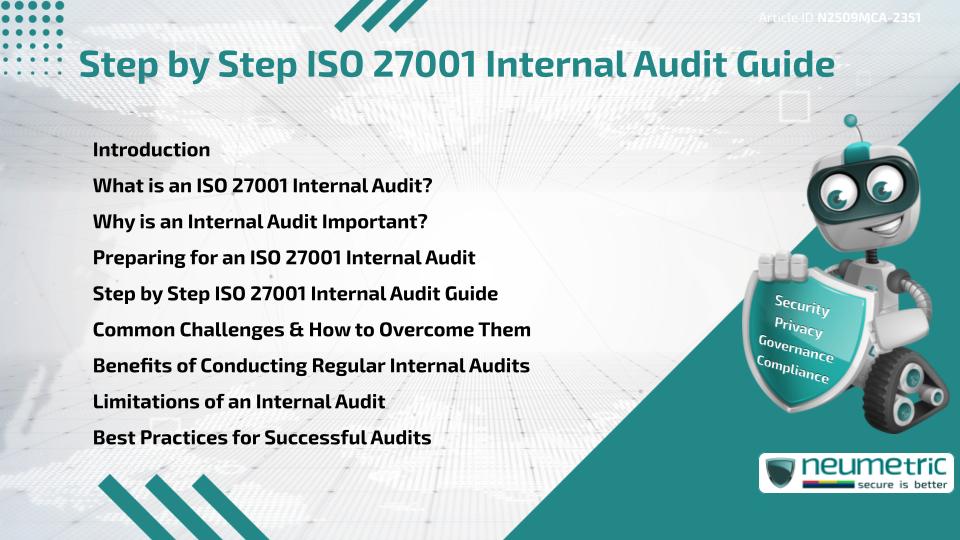Table of Contents
ToggleIntroduction
The Step by Step ISO 27001 Internal Audit Guide is an essential resource for Organisations aiming to maintain Compliance with ISO 27001 standards. An Internal Audit ensures that Information Security Management Systems [ISMS] are operating effectively, Risks are controlled & Compliance is maintained. This article explains what an Internal Audit is, why it matters, how to prepare for it & the specific steps involved. It also covers common challenges, limitations & Best Practices to help Organisations conduct effective Audits.
What is an ISO 27001 Internal Audit?
An ISO 27001 Internal Audit is a structured review of an organisation’s ISMS against the requirements of the ISO 27001 standard. Unlike external Certification Audits, internal Audits are performed by trained individuals within the organisation or independent consultants. The purpose is to confirm whether the ISMS meets Requirements, identify Gaps & suggest Improvements.
Why is an Internal Audit Important?
Internal Audits serve as a health check for the ISMS. They:
- Highlight Non-Conformities before an External Auditor finds them
- Ensure Compliance with ISO 27001 Clauses & Controls
- Build confidence among Stakeholders & Customers
- Reduce the Risk of Security Incidents by identifying weaknesses early
Without an Internal Audit, Organisations Risk failing external Certification or missing critical Vulnerabilities.
Preparing for an ISO 27001 Internal Audit
Preparation is the backbone of a successful Audit. Organisations should:
- Define the Audit scope, covering relevant ISO 27001 Clauses & annex Controls
- Create an Audit plan with clear timelines
- Assign qualified Internal Auditors who understand ISO 27001
- Gather necessary documentation such as Risk Assessments, Policies & Procedures
- Communicate expectations with relevant departments
Step by Step ISO 27001 Internal Audit Guide
Following a systematic process makes Audits more effective:
- Define Scope – Determine the boundaries & areas to be Audited.
- Prepare Audit Plan – Outline objectives, methods & timelines.
- Conduct Opening Meeting – Set expectations with participants.
- Collect Evidence – Review documents, interview Staff & observe Processes.
- Evaluate Compliance – Check alignment with ISO 27001 Requirements.
- Identify Non-Conformities – Record areas where requirements are not met.
- Report Findings – Present results to management with actionable recommendations.
- Conduct Closing Meeting – Summarise findings & next steps.
- Follow Up – Ensure Corrective Actions are implemented & verified.
Common Challenges & How to Overcome Them
Organisations often face challenges such as limited resources, lack of Auditor independence or incomplete documentation. Overcoming these requires:
- Providing Auditor training
- Ensuring segregation between Auditee & Auditor roles
- Maintaining up-to-date Records & Evidence
- Using Audit Checklists to ensure thorough coverage
Benefits of Conducting Regular Internal Audits
Regular Audits:
- Improve ISMS effectiveness
- Promote Continuous Improvement
- Reduce Risks related to Confidentiality, Integrity & Availability of information
- Strengthen Employee Awareness of security responsibilities
Limitations of an Internal Audit
While Internal Audits are valuable, they have limitations. Auditors may lack complete independence, resources can be constrained & findings may be influenced by internal bias. This is why balancing Internal Audits with External Assessments is crucial.
Best Practices for Successful Audits
To maximise success:
- Schedule Audits regularly rather than reactively
- Use Risk-based Auditing to focus on critical areas
- Encourage openness from Employees during interviews
- Document everything clearly for Accountability
Takeaways
- Preparation is the foundation of an effective Internal Audit
- Following a structured step-by-step process ensures thorough coverage
- Continuous Improvement strengthens the ISMS & reduces Risks
- regular Audits maintain Compliance & build Stakeholder Trust
FAQ
What is the purpose of an ISO 27001 Internal Audit?
It ensures that the ISMS complies with ISO 27001 requirements, identifies Gaps & improves Information Security Controls.
Who should perform an ISO 27001 Internal Audit?
Qualified internal Auditors or independent Consultants who are knowledgeable about ISO 27001 & Audit practices.
How often should internal Audits be conducted?
At least once a year or more frequently depending on the organisation’s Risk environment & Certification requirements.
What documents are required for an Internal Audit?
Risk Assessments, Security Policies, Procedures, Training Records, Incident Logs & Management Review Minutes are commonly needed.
What happens after an Internal Audit is completed?
Findings are reported, Corrective Actions are planned & follow-ups are conducted to ensure issues are resolved.
Can internal Audits replace external Certification Audits?
No, internal Audits prepare for external Certification but cannot replace them. External Audits are mandatory for ISO 27001 Certification.
What are common mistakes during an Internal Audit?
Poor preparation, lack of objectivity, incomplete records & focusing only on documentation instead of real practices.
Need help for Security, Privacy, Governance & VAPT?
Neumetric provides organisations the necessary help to achieve their Cybersecurity, Compliance, Governance, Privacy, Certifications & Pentesting needs.
Organisations & Businesses, specifically those which provide SaaS & AI Solutions in the Fintech, BFSI & other regulated sectors, usually need a Cybersecurity Partner for meeting & maintaining the ongoing Security & Privacy needs & requirements of their Enterprise Clients & Privacy conscious Customers.
SOC 2, ISO 27001, ISO 42001, NIST, HIPAA, HECVAT, EU GDPR are some of the Frameworks that are served by Fusion – a SaaS, multimodular, multitenant, centralised, automated, Cybersecurity & Compliance Management system.
Neumetric also provides Expert Services for technical security which covers VAPT for Web Applications, APIs, iOS & Android Mobile Apps, Security Testing for AWS & other Cloud Environments & Cloud Infrastructure & other similar scopes.
Reach out to us by Email or filling out the Contact Form…


